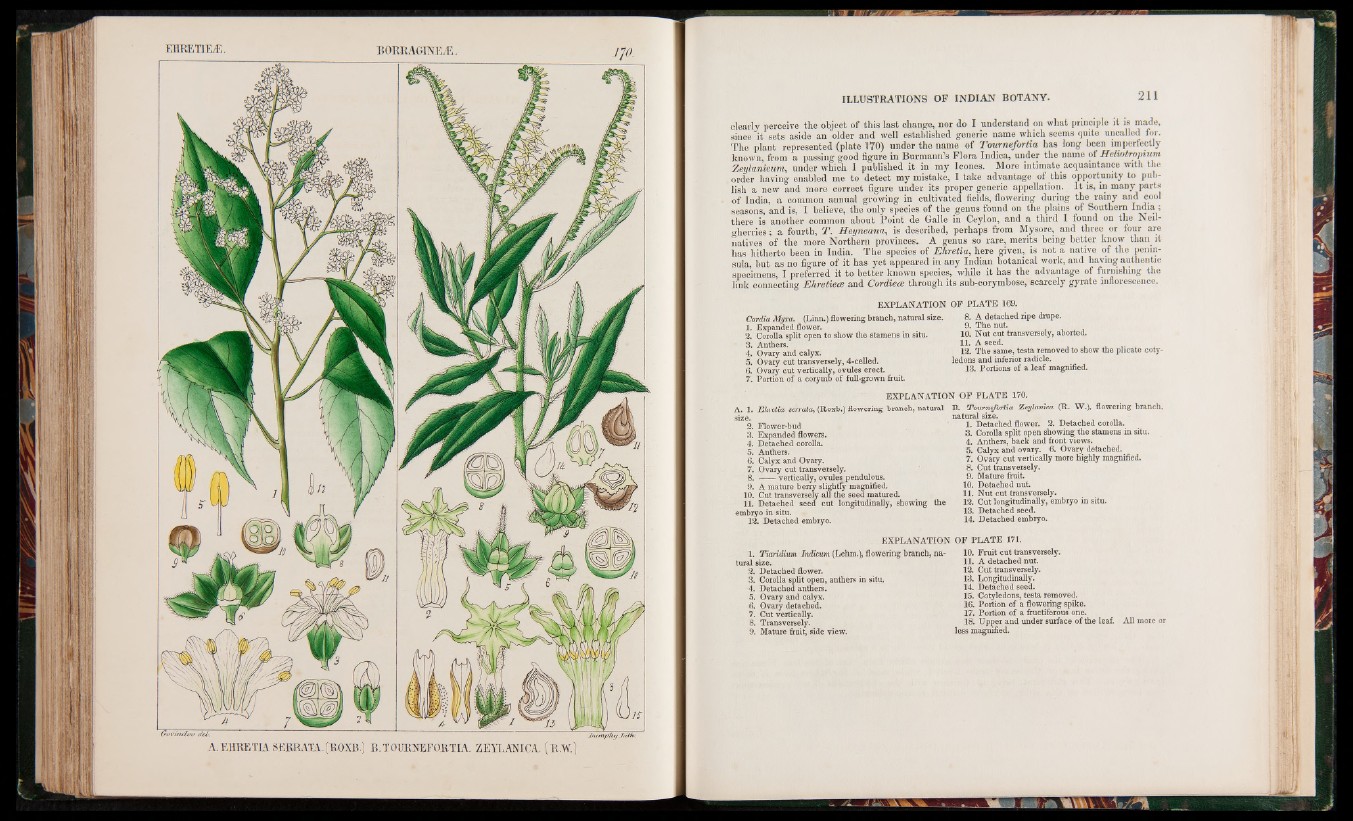
A . E H R E T I A S E K R A I A . ( R O X B ) R . T O U R N E E O R T I A . Z E Y L A N I C A . ( R .W . )
clearly perceive the object of this last change, nor do I understand on what principle it is made,
since it sets aside an older and well established generic name which seems quite uncalled for.
The plant represented (plate 170) under the name of Tournefortia has long been imperfectly
known, from a passing good figure in Burmann’s Flora Indica, under the name of Heliotropium
Zeylanicum., under which I published it in my leones. More intimate^ acquaintance with the
order having enabled me to detect my mistake, I take advantage of this opportunity to publish
a new and more correct figure under its proper generic appellation. I t is, in many parts
of India, a common annual growing in cultivated fields, flowering during the rainy and cool
seasons, and is, I believe, the only species of the genus found on the plains of Southern India ;
there is another common about Point de Galle in Ceylon, and a third I found on the Neil-
gherries; a fourth, T. Heyneana, is described, perhaps from Mysore, and three or four are
natives of the more Northern provinces. A genus so rare, merits being better know than it
has hitherto been in India. The species of Ehretia, here given, is not a native of the peninsula,
but as no figure of it has yet appeared in any Indian botanical work, and having authentic
specimens, I preferred it to better known species, while it has the advantage of furnishing the
link connecting Ehretiece and Cordiece through its sub-corymbose, scarcely gyrate inflorescence.
EXPLANATION OF PLATE 169.
Cordia Mym. (Linn.) flowering branch, natural size.
1. Expanded flower.
2. Corolla split open to show the stamens in situ.
3. Anthers.
4. Ovary and calyx.
5. Ovary cut transversely, 4-celled.
6. Ovary cut vertically, ovules erect.
7. Portion of a corymb of full-grown fruit.
8. A detached ripe drupe.
9. The nut.
10. Nut cut transversely, aborted.
11. A seed.
12. The same, testa removed to show the plicate cotyledons
and inferior radicle.
13. Portions of a leaf magnified.
EXPLANATION OF PLATE 170.
A. 1. Ehretia serrata, (Roxb.) flowering branch, natural
size.2
. Flower-bud
3. Expanded flowers.
4. Detached corolla.
5. Anthers.
6. Calyx and Ovary.
7. Ovary cut transversely.
8. ------ vertically, ovules pendulous.
9. A mature berry slightly magnified.
10. Cut transversely all the seed matured.
11. Detached seed cut longitudinally, showing the
embryo in situ.
12. Detached embryo.
B. Tournefortia Zeylanica (R. W.), flowering branch,
natural size.
1. Detached flower. 2. Detached corolla.
3. Corolla split open showing the stamens in situ.
4. Anthers, back and front views.
5. Calyx and ovary. 6. Ovary detached.
7. Ovary cut vertically more highly magnified.
8. Cut transversely.
9. Mature fruit.
10. Detached nut.
11. Nut cut transversely.
12. Cut longitudinally, embryo in situ.
13. Detached seed.
14. Detached embryo.
EXPLANATION OF PLATE 171.
1. Tiaridium Indicum (Lehm.), flowering branch, natural
size.
2. Detached flower.
3. Corolla split open, anthers in situ.
4. Detached antners.
5. Ovary and calyx.
6. Ovary detached.
7. Cut vertically.
8. Transversely.
9. Mature fruit, side view.
10. Fruit cut transversely.
11. A detached nut.
12. Cut transversely.
13. Longitudinally.
14. Detached seed.
15. Cotyledons, testa removed.
16. Portion of a flowering spike.
17. Portion of a fructiferous one.
18. Upper and under surface of the leaf. All more or
less magnified.